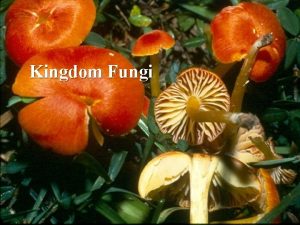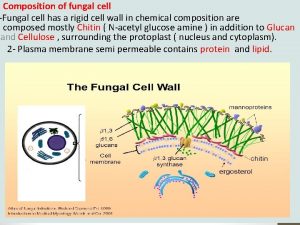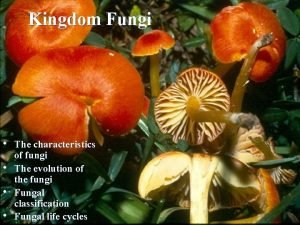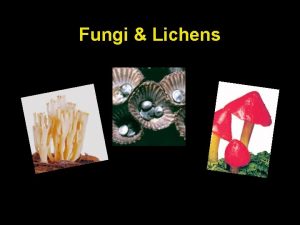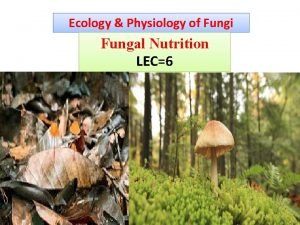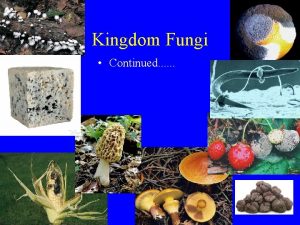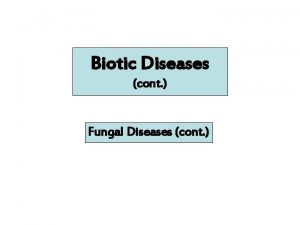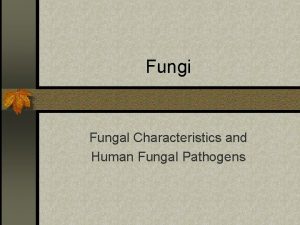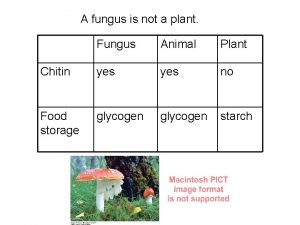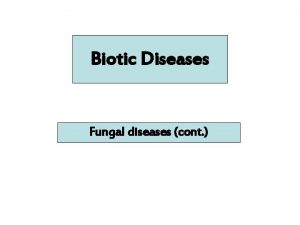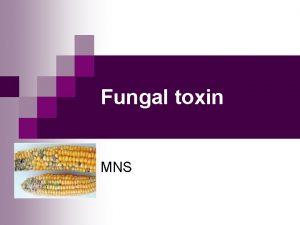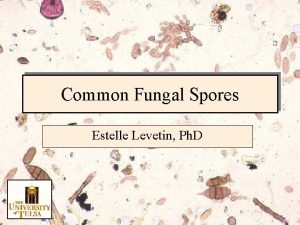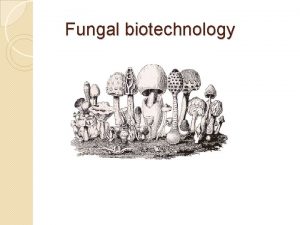Chapter Six Fungal Diseases of Plants Fungus can



























- Slides: 27

Chapter Six

Fungal Diseases of Plants • • • Fungus can infect plant also Examples of fungal plant pathogens: Lawn diseases Apple scab Fire blight Dr. Nahlaa Khalifa 2

Fungal Diseases of Plants Dr. Nahlaa Khalifa 3

Common Mold, Rhizopus, Decomposing Strawberries Dr. Nahlaa Khalifa 4

A Moldy Orange & Penicillium Dr. Nahlaa Khalifa 5

Irish potato famine § § Irish Potato Famine (1845) 1 million deaths, massive migration Caused by potato blight fungus Phytophthora infestans Dr. Nahlaa Khalifa 6

Anti-fungal agents § § Anti-fungal therapy can be divided into two categories ; Treatment of serious systemic (deep) mycosis Superficial mycosis involving skin and mucous membranes Affect of antifungal drugs : synthesis and function of cell walls or of hydroxylated glycerols and ergosterol Dr. Nahlaa Khalifa 7

FOOD FERMENTATIONS 8

Food Fermentation – Definition §Fermentation is the metabolic (partial breakdown) process in which carbohydrates complex sugars and related compounds are partially oxidised, into simple compounds like carbon dioxide and alcohol. with the release of energy §With fermentation, incomplete breakdown of the parent compound occurs and only a small amount of energy is released during the process. § Fermentation changes the product from one food to another. Dr. Nahlaa Khalifa 9

Food Fermentation – Definition q Fermentation is the process of breaking down pyruvic acid without O 2 in the cytoplasm. q There are two types of fermentation § Lactic Acid Fermentation § Alcoholic Fermentation q Both types of fermentation regenerate NAD+, an electron acceptor, that is used in glycolysis. Dr. Nahlaa Khalifa 10

Lactic Acid Fermentation q It is the conversion of pyruvic acid to lactic acid. During exercise muscle cells become depleted of oxygen, resulting in the production of lactic acid, which causes fatigue, pain, and cramping. Microorganisms also use this to produce yogurt and cheese. Dr. Nahlaa Khalifa 11

Alcohol Fermentation q Converts pyruvic acid into ethyl alcohol. Alcoholic Fermentation is used to make wine, beer, and bread by using yeast cells that produce CO 2. Dr. Nahlaa Khalifa 12

Fermented Foods

Fermented Foods § § § Foods that have been subjected to the action of micro-organisms or enzymes, in order to bring about a desirable change. Numerous food products owe their production and characteristics to the fermentative activities of microorganisms. Fermented foods originated many thousands of years ago when micro-organism contaminated local foods. Dr. Nahlaa Khalifa 14

Fermented Foods • Cheese and yogurt – Lactic acid fermentation produces yogurt and cheese. Some fungi are also used to make the cheese turn blue! • Bread and dough products Lactobacilli bacteria used in yogurt and cheese making – Yeast is used to make bread and dough products. • Alcohol Production – Yeast is also used in alcohol production when fermentation occurs without air Saccharomyces cerevisiae yeast used in bread making and alcohol production

Types of Fermented Foods q Fermented foods comprise about one-third of the world wide consumption of food and 2040 % (by weight) of individual diets. Examples are § Dairy § Meat § Vegetable § Bread § Cereal § Beverage § Vinegar and other acids § Others 16

Benefits of Fermentation q. Food preservation § Inhibit pathogens § Inhibit spoilage organisms q. Extend shelf-life considerably over that of the raw materials from which they are made q. Improve organoleptic characteristics § Flavor § Texture § Odor 17

Benefits of Fermentation q. Increase Nutrient Density § Complex nutrients into simple § Breakdown plant structures § Synthesize vitamins q Enhanced functionality q New products (uniqueness) q Increased economic value 18

Controlled vs. Natural Fermentation q Natural fermentation – Create conditions to inhibit undesirable fermentation yet allow desirable fermentation – Examples: • Lambic fermentation – Beer-like beverage • Vegetable fermentations – Vegetables + salt Dr. Nahlaa Khalifa 19

Controlled vs. Natural Fermentation q Controlled fermentation – Deliberately add microorganisms to ensure desired fermentation • Example: fermented dairy products – Lactose … Lactic acid – Starter culture » Lactics or Lactic starter or Lactic acid bacteria (LAB) Dr. Nahlaa Khalifa 20

Microorganisms Used in Food Fermentations • Lactic acid producing bacteria – Homofermentative LAB – Heterofermentative LAB • Ethanol producing yeast – Saccharomyces cerevisiae • Flavor producing microorganisms – Bacteria, yeasts, molds • Acetic acid producing bacteria – Acetobacter Dr. Nahlaa Khalifa 21

Yeast Starter Cultures § Bread manufactures largest users of yeast starter cultures § Several forms Moist yeast cakes, active dry yeast packages, etc. § Saccharomyces cerevisae § Produce large amount of CO 2 § Fermented alcoholic beverage also use yeast cultures § Have characteristic difference, although all belong to S. cerevisae Dr. Nahlaa Khalifa 22

Mold Starter Cultures • In cheese making – Blue mold cultures consist of spore suspensions of Penicillium roqueforti and white mold cheese cultures contain P. camemberti • Soy-derived fermented foods – Tempeh: Prizopus microsporus – Miso and soy sauce: Aspergillus sojae and A. oryzae Dr. Nahlaa Khalifa 23

Examples of Fermented Foods q. Bread § Involves growth of Saccharomyces cerevisiae (baker’s yeast) under aerobic conditions § Maximizes CO 2 production, which leavens bread § Other microbes used to make special breads (e. g. , sourdough bread) § Can be spoiled by Bacillus species that produce ropiness Dr. Nahlaa Khalifa 24

Examples of Fermented Foods q Yogurt §Milk is feremented by a mixture of Streptococcus salivarius ssp thermophilus and Lactobacillus bulgaricus (official name Lactobacillus delbrueckii ssp. bulgaricus). Often these two are cocultured with other lactic acid bacteria for taste or health effects (probiotics). These include L. acidophilus, L. casei and Bifidobacterium species. §Acid produced from the fermentation causes the protein in the milk (casein) to coagulate into a semisolid curd. If you want strawberries or peaches, you must add them after the yogurt is made Dr. Nahlaa Khalifa 25

Examples of Fermented Foods q. Cheese §Milk is treated with lactic acid bacteria and an enzyme called rennin that partially hydrolyses the protein and causes it to coagulate into “curds. ” The liquid portion of the milk at this time is called “whey. ” §The whey is separated from the curds, and the curds are aged (“ripened”) §Different microbes in the early and late stages of processing give rise to cheeses with different characteristics Dr. Nahlaa Khalifa 26

Asian Fermented Foods § § § § § Soy sauce- fermented soybean souce Miso (Japan)-fermented soybean paste Tempeh (Indonesia)-fermented soybean Sufu (China)-fermented soybean curd Natto (Japan)Lao chao (China)-fermented rice Tape ketan (Indonesia)-fermented rice Ang-kak (Korea)-fermented rice Ontjam (Indonesia)-fermented peanut press cake Dr. Nahlaa Khalifa 27
 General fungal life cycle
General fungal life cycle Fungal cell walls are characteristic in having
Fungal cell walls are characteristic in having Single celled fungi
Single celled fungi What conditions do fungal organisms favor for growth?
What conditions do fungal organisms favor for growth? Histoplasmosis uveitis
Histoplasmosis uveitis Allergic fungal sinusitis
Allergic fungal sinusitis What conditions do fungal organisms favor for growth
What conditions do fungal organisms favor for growth Dikaryotic fungal life cycle
Dikaryotic fungal life cycle Menigitis csf
Menigitis csf Fungal reproduction
Fungal reproduction Evolution of fungi
Evolution of fungi Clasification of fungi
Clasification of fungi Haustorium in fungi
Haustorium in fungi Allergic fungal sinusitis treatment
Allergic fungal sinusitis treatment Contoh gambar jamur zygomycota
Contoh gambar jamur zygomycota Fern is vascular or nonvascular
Fern is vascular or nonvascular Nonvascular plants reproduction
Nonvascular plants reproduction Non flowering plants characteristics
Non flowering plants characteristics C3 plant
C3 plant Chapter 24 lesson 1 sexually transmitted diseases
Chapter 24 lesson 1 sexually transmitted diseases Define a primary skin lesion and list three types
Define a primary skin lesion and list three types Chapter 6 musculoskeletal system diseases and disorders
Chapter 6 musculoskeletal system diseases and disorders Chapter 32 childhood communicable diseases bioterrorism
Chapter 32 childhood communicable diseases bioterrorism Chapter 24 sexually transmitted diseases and hiv/aids
Chapter 24 sexually transmitted diseases and hiv/aids Chapter 23 lesson 2 common communicable diseases
Chapter 23 lesson 2 common communicable diseases Chapter 22 genetics and genetically linked diseases
Chapter 22 genetics and genetically linked diseases Chapter 21 mental health diseases and disorders
Chapter 21 mental health diseases and disorders Chapter 17 reproductive system diseases and disorders
Chapter 17 reproductive system diseases and disorders

